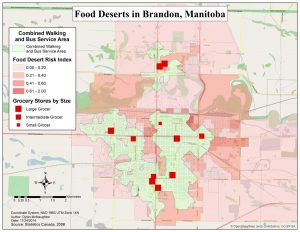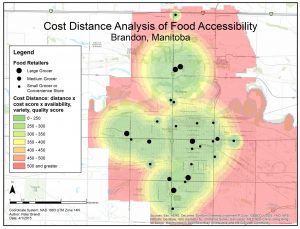
By
Nancy McPherson, Derrek Eberts, Dion Wiseman, Peter Brandt, Dylan McNaughton, and Erin May
January 2020
Print Version
What you need to know
The objective of this study was to explore food security through an equity lens in Brandon. Food security refers to all people at all times having access to sufficient, safe, nutritious food to maintain a healthy and active life. Community food security takes it one step further—examining whether the community as a whole is food secure. Community food security includes social concerns, access to food, quantity and quality of food available, and policies and programs that support food security.
Brandon University and the Brandon Neighborhood Renewal Corporation teamed up to examine the concept of equity within Brandon’s foodscape. Two key questions were explored:
- What is in place within the City of Brandon that promotes food security?
- What ought to be in place within the City of Brandon to promote food security?
Why this research is important
The health status of community residents is largely driven by the social determinants of health, which are the economic and social conditions that shape the health of individuals and communities as a whole. These are the circumstances in which people are born, grow up, live, learn, work, and age as well as the systems in place to help manage those circumstances. The notion of food security is inextricably linked with several health determinants, income in particular. The foundation of health equity is the belief that all people can reach their full potential and should not be disadvantaged because of their social and economic status, social class, race, ethnicity, religion, age, disability, gender, gender identity, sexual orientation or any other socially determined circumstance. Health inequities are systematically associated with underlying social disadvantage. They reflect unequal opportunities to be healthy and are therefore considered to be avoidable, unjust, and unfair, making food security a social justice issue.
How this research was conducted
This study gathered information about affordability, accessibility, availability, and preferences regarding food choices in Brandon, the ability of residents to use that food safely, and existing food-related resources and policies in the city. Data were gathered through a community-wide household survey, key informant interviews with community stakeholders working with potentially food-insecure residents, and an environmental scan of existing community resources and food-related policies within the city of Brandon. Geographic Information System (GIS) mapping was used to better understand the relationship between the built environment and access to food.
What the researchers found
Study participants reported varying degrees of public awareness about community food resources and services. For those seeking community-based food support, food hampers and the local soup kitchen were identified as being accessed most often. Farmers’ markets were well used, but perceptions about the higher cost of fair trade food products prohibited many individuals from purchasing them. There was strong support for community gardens throughout the city. The majority of respondents obtained their foodstuffs from local supermarkets; however, GIS mapping of retail food outlets provided evidence of food deserts in Brandon. Food deserts occur when people have limited access to healthy food due to socioeconomic constraints or health issues that limit their mobility. As a result, supermarkets located far from where people live may be inaccessible for many.
This study found a number of high-risk areas for food insecurity and two specific food deserts: one on the eastern edge of downtown and the other in the southern portion of the city. Those residing in these areas may be forced to purchase their groceries at a local convenience store or find the means to travel a greater distance. This finding is important for urban planning and healthy public policy development.


How this research can be used
Findings from this study support and inform food-related programming and policies by local agencies and organizations, and the municipal government. Examples include:
- Integration of community gardens in the City of Brandon recreational hub concept
- Food skills workshops and training throughout the city
- Creation of the Brandon Food Council
- Commercial kitchen for public use in downtown Brandon
Acknowledgements
Financial support for this study was provided by: Neighbourhoods Alive!, Brandon Neighbourhood Renewal Corporation, Brandon & Area Community Foundation, and Healthy Brandon.
About the Researchers
Keywords
- determinants of health
- food deserts
- food security
- health inequities
- social injustice
Editor: Christiane Ramsey
Read more BU Research
Research at Brandon University follows comprehensive policies designed to safeguard ethics, to ensure academic integrity, to protect human and animal welfare and to prevent conflicts of interest.



